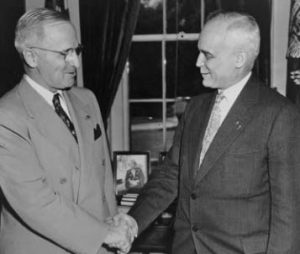September 18, 1945
In all of the Senate’s history, only seven incumbent members have moved directly to the Supreme Court—the most recent being in 1945. Seven others were seated within a few years of leaving the Senate—the most recent being in 1949.
In the summer of 1945, the retirement of Justice Owen Roberts presented a political challenge to Harry Truman, who had been president for only three months. The seven remaining associate justices had gained their seats as Democratic appointees of President Franklin Roosevelt. In a gesture designed to improve relations with Republican congressional leaders, the new Democratic president decided to appoint a Republican.

In making his decision, President Truman consulted with Chief Justice Harlan Stone, the Court’s only Republican, to see if Ohio Republican Senator Harold Burton would be acceptable. Truman and Burton had become friends when they served together on the Senate Special Committee to Investigate the National Defense Program. Chief Justice Stone welcomed the appointment on the theory that Burton’s Senate experience would be useful in helping the Court determine legislative intent as it reviewed statutes.
Truman’s decision was not entirely altruistic. In sending a Republican to the Court, the president knew that the Democratic governor of Ohio was prepared to replace Burton in the Senate with a Democrat.
Three years later, in 1949, Truman named his former Senate seat-mate, Indiana Democrat Sherman Minton, to the Supreme Court. Minton had come to the Senate with Truman in 1935 as part of a 13-member all-Democratic freshman class.
During his seven years on the Court, Justice Minton occasionally strolled onto the Senate floor to listen to debate. Today, he is remembered as the last member of Congress—incumbent or former—to receive a Supreme Court appointment.
List of Senators Who Served on the Supreme Court
Further Reading
200 Notable Days: Senate Stories 1787-2002. Richard A. Baker. Washington, DC: U.S. Government Printing Office, 2006.
200 Notable Days: Senate Stories 1787-2002 includes essays about the landmark days that shaped the Senate as an institution. Arranged chronologically, this book of days collectively reveals the character of the “World’s Greatest Deliberative Body.”
